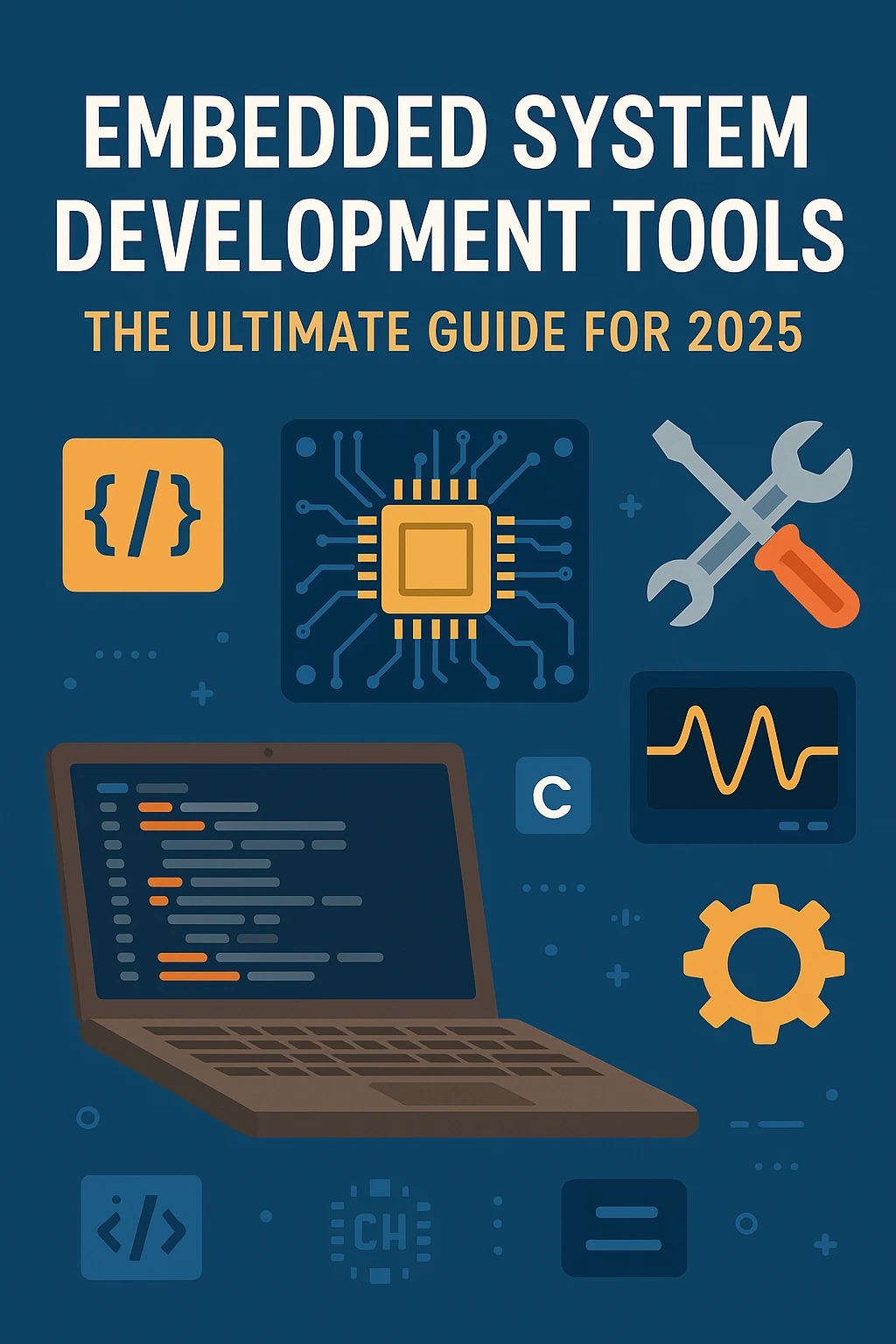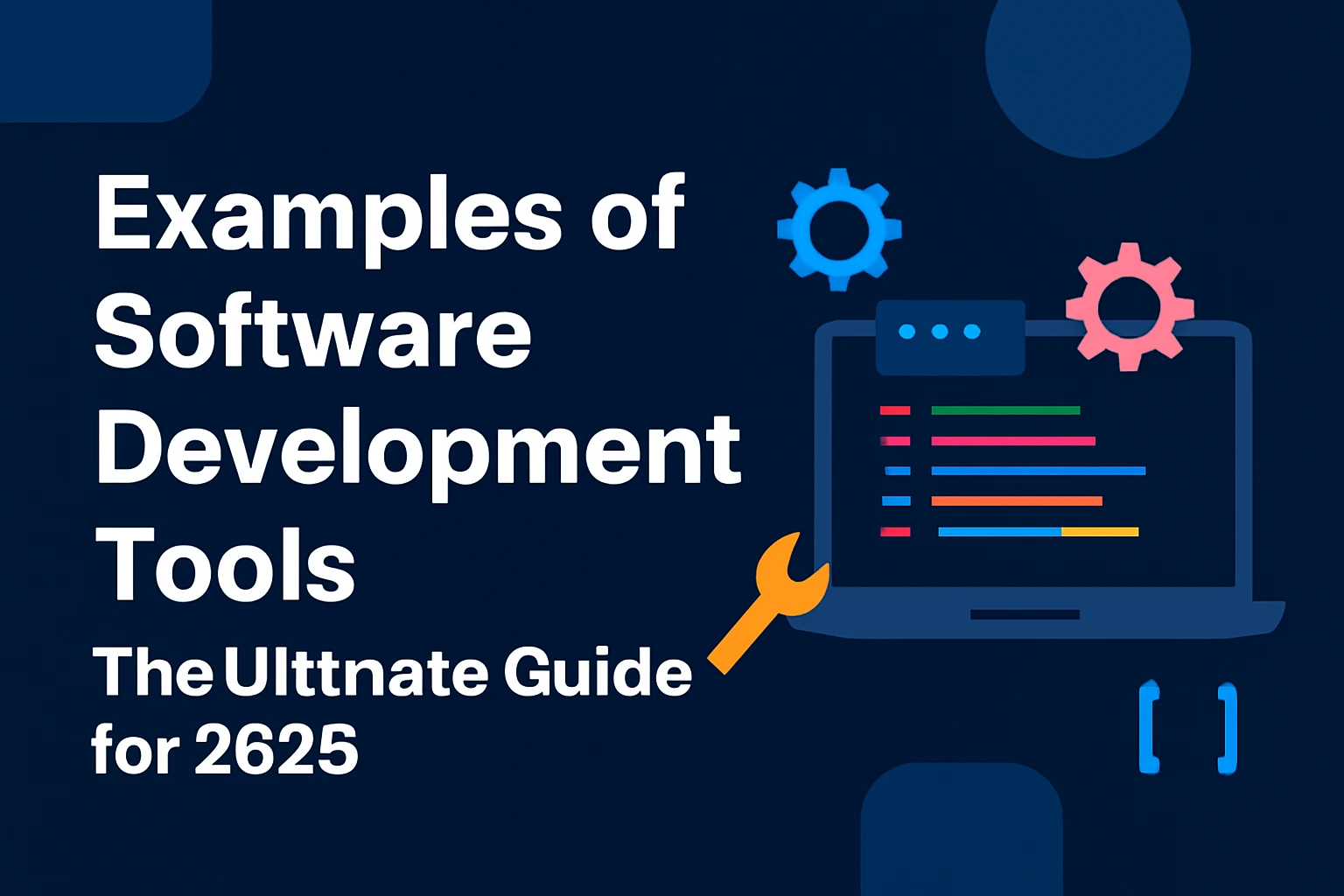Embedded System Development Tools: The Ultimate Guide for 2025

Table of Contents
- Introduction : Embedded System Development Tools: The Ultimate Guide for 2025
- What is Embedded Systems Development?
- Core Components of Embedded Systems
- Various Embedded System Development Tools
- Popular Embedded System Development Tools by Application
- Workflow Walkthrough: Leveraging an IDE for Embedded Systems
- Comparison Criteria: How to Choose the Right Tool
- Best Practices for Embedded System Development
- 1. Start with Clear Requirements and System Architecture
- 2. Adopt a Structured Development Process
- 3. Choose the Right Tools and Languages
- 4. Prioritize Code Quality and Maintainability
- 5. Testing, Debugging, and Validation
- 6. Focus on Security and Safety
- 7. Optimize for Performance and Resource Constraints
- 8. Documentation and Knowledge Sharing
- 9. Plan for Scalability and Future Trends
- 10. Foster Cross-Disciplinary Collaboration
- Recent Trends and Advancements (2025)
- 1. AI-Driven Development Tools
- 2. Mainstreaming of RISC-V and New Hardware Architectures
- 3. Open-Source Software and Toolchain Dominance
- 4. Security-First Development Workflows
- 5. Edge Computing and Real-Time AI Frameworks
- 6. Modern Programming Languages and Safety
- 7. DevSecOps and Hardware-in-the-Loop (HIL) Integration
- 8. Containerization and Service-Oriented Architectures
- 9. Low-Code and Democratized Development
- 10. Enhanced IDEs and Tool Integration
- Conclusion
- FAQs
Introduction : Embedded System Development Tools: The Ultimate Guide for 2025
They are the backbone of our wireless world, hidden the as smart thermostat at home, or as wearable, or as automotive safety systems, or as industry robots. Widely successful embedded products all rely on a Embedded System Development Tools suite that allows engineers to design, code, test, and deploy reliable, efficient, and secure solutions.
Let this guide become your no-nonsense, no-frills, go-to guide for understanding embedded system development tools in 2025. If you are a beginner or a backend engineer or interested in technology, you will discover a wealth of practical tips, workflows, and insights that will guide you in successful embedded development; this in-depth resource includes articles on the latest trends.
What is Embedded Systems Development?
Embedded systems development refers to the process of developing software and firmware that runs on computers called embedded systems which are dedicated to particular functions within a mechanical or electrical system. In contrast to general-purpose computers that can run any software, an embedded system is designed to execute a predetermined set of functions, often with strict constraints on physical size, power, cost, and reliability.
Key Characteristics
- Specialized Functionality: Intended for a dedicated function (like controlling a washing machine, car engine, or keeping track of patient vitals).
- Hardware-Software Integration: Its software suffers from a tight-coupling of the software with the hardware, and it fulfills the platform requirements, usually running on very limited resource device, microcontroller (MCU) or microprocessor (MPU).
- Time-Constrained Operation: Implicitly or explicitly, many embedded systems feature inputs or events that must be responded to within a specific amount of time.
- Resource Limited: More efficient than other applications, for they run usually in less memory, process power, and energy.
- Reliable and stable: Typically, serve functions in which failures are not allowed (e.g. automotive safety, medical devices).
Core Components of Embedded Systems
| Component | Description |
|---|---|
| Hardware | Microcontroller/processor, memory (RAM, ROM, Flash), I/O interfaces |
| Software | Firmware, device drivers, RTOS, application layer |
| Development Tools | IDEs, compilers, debuggers, simulators, version control |
Embedded tools for system development connects your concepts and a functioning and dependable product. They assist you in writing, testing, debugging, and optimizing code for low-resource hardware.
Various Embedded System Development Tools
Development tools for embedded systems can be classified into different groups as per their respective roles in the development life cycle:
1. Integrated Development Environments (IDEs)
- All-in-one IDE that offers a single interface for writing, compiling, debugging, and sometimes simulating.
- Type: Eclipse based, Keil µVision, STM32CubeIDE,MPLAB X, IAR Embedded Workbench (6), AccuRev VCS Such as Qt Creator.
2. Compilers and Toolchains
- Translate high-level code (C, C++, Rust, etc.) to machine code for the target hardware.
- Sample: GCC, Keil C51, TASKING Viper, MPLAB XC, Arm Compiler
3. Debuggers and Emulators
- Enable debug-by-step code execution, variable inspection and real-time analysis.
- Some examples are GDB, J-Link, ST-Link, iSYSTEM winIDEA, and IDA Pro.
4. Simulators and Virtual Hardware
- Test and validate code without the need for physical hardware
- Eg: Proteus, ARM Virtual Hardware, QEMU.
5. Protocol and Logic Analyzers
- Communication protocols (I2C, SPI, CAN, etc.) monitoring and debugging.
- Examples: Beagle I2C/SPI Analyzer, Aardvark Host Adapter
6. Middleware, Libraries, and Frameworks
- Give RTOS, communication stacks & device driver reusable code.
- Examples are RTOS such as FreeRTOS, Zephyr, AUTOSAR, final code level Software Architecture such as S32 Safety Software Frame work.
7. Tools For Testing, Validation And Static Analysis
- To make sure code quality, safety and industry standards compliance.
- Examples: TESSY, VectorCAST, Klocwork, LDRA.
Popular Embedded System Development Tools by Application
IoT Applications
The Internet of Things (IoT) demands tools that are easy to use, scalable, and support rapid prototyping and cloud integration.
| Tool/Platform | Key Language(s) | Notable Features | Typical IoT Use Cases |
|---|---|---|---|
| Arduino | C/C++ | Simple IDE, large library ecosystem | Home automation, wearables |
| Eclipse IoT | Java (+plugins) | Modular, open-source | Industrial IoT, smart cities |
| Node-RED | JavaScript | Visual programming, rapid prototyping | Home automation, data flows |
| Tessel 2 | JavaScript | Plug-and-play modules, Node.js | Prototyping, education |
| Particle.io | C/C++ | Cloud integration, device management | Industrial IoT, remote monitoring |
| Home Assistant | Python | Home automation, privacy-focused | Smart homes, energy management |
| Keil MDK | C/C++ | Arm Cortex-M, RTOS, simulation | Sensor nodes, wireless devices |
| Arm Dev Studio | C/C++ | Cloud IDE, virtual hardware | Edge AI, secure IoT devices |
| MPLAB X | C/C++ | Multi-microcontroller support | Industrial controllers, sensors |
| Qt Creator | C++, QML | GUI design, cross-platform | IoT gateways, smart appliances |
Automotive Applications
Automotive embedded systems require tools that support safety, real-time performance, and compliance with standards like ISO 26262.
| Tool/Framework | Main Use Case | Key Features/Notes |
|---|---|---|
| Eclipse IDE | General automotive embedded dev | Plugin support, AUTOSAR tools, debugging |
| MPLAB X | Microchip MCU development | Cross-platform, advanced debugging |
| Visual Studio + VisualGDB | Cross-platform, IoT, Linux targets | Local/remote debugging, GNU toolchain integration |
| Qt Creator | HMI, infotainment, UI | 2D/3D UI, cross-compiling, on-device debugging |
| TASKING Viper Compiler | Safety-critical, ISO 26262 | ASPICE, static analysis, multicore SoC support |
| Keil C51 | 8051 MCU development | C code generation, simulation |
| GNU Toolchain | General embedded dev | Open-source, portable, widely supported |
| iSYSTEM Debugging Tools | Real-time debugging, test automation | Multicore, trace analysis, test APIs |
| AUTOSAR | Standardized automotive software | Abstraction, interoperability, safety |
| S32 Safety Software Framework | Safety-critical NXP applications | ISO 26262, safety drivers, model-based design |
| MATLAB/Simulink + MBDT | Model-based design, simulation | Rapid prototyping, code generation |
Industrial Applications
Industrial embedded systems demand robustness, scalability, and support for a wide range of hardware and protocols.
| Tool/IDE | Key Use in Industry | Notable Features |
|---|---|---|
| Eclipse | Automation, control, robotics | Plugin support, cross-compilation, debugging |
| MPLAB X | Sensor networks, robotics | Multi-microcontroller support, live syntax check |
| Qt Creator | HMI, control panels | GUI design, cross-compiling, safety features |
| Visual Studio + VisualGDB | IoT gateways, controllers | Remote debugging, GNU toolchain integration |
| Keil MDK | Motor control, automation | Arm Cortex-M support, RTOS, safety certification |
| Proteus | PCB, sensor interface simulation | Circuit simulation, microcontroller emulation |
| Beagle/Aardvark | Protocol debugging | Real-time data capture, protocol analysis |
| ST-Link/J-Link | In-circuit debugging | Real-time debugging, multi-IDE support |
Workflow Walkthrough: Leveraging an IDE for Embedded Systems
Lets go through a typical workflow through yet another overused embedded system IDE (STM32CubeIDE, Keil µVision or MPLAB X):
Install the IDE and Toolchain
1: Download the IDE from official website.
- Install any necessary toolchains, for example ARM GCC, MPLAB XC.
- If required, install drivers for your developmental board.
2. Create a New Project
Launch IDE and Click on File -> New Project.
Microcontroller or Development board selection
Give the name and location of the project.
3. Configure Project Settings
Pick Wrong Device Family And Part Number
Configures clock, peripherals and middleware
STM32CubeIDE: Configure pins and peripherals with graphical configuration tool
4. Write Your Code
Open your main source file (most likely main. c or main. cpp).
Enter or paste the embedded C/C++ code there.
Include some header files or libraries needed.
5. Build the Project
Press the Build or Compile button.
Error messages or warnings will pop up on the output window.
If you have any problems, repair it and reconstruct it, as desired.
6. Flash the Code to the Device
Attach your development board using USB or programmer
Select the correct debug/programming interface.
Click on Download / Flash to upload the code.
7. Debug and Test
Place breakpoints into your code if required.
Start a debug session.
You may have to debug your code in either IME (Step, run, watch variables, etc …) to see what the issue is.
8. Monitor Output
Output from the Device Use the serial monitor of IDE or external terminal.
Iterate — based on results as appropriate.
Comparison Criteria: How to Choose the Right Tool
Selecting the right embedded system development tool is critical for project success. Here are the most important criteria to consider:
| Criterion | Why It Matters | Example Tools/Features |
|---|---|---|
| Hardware Support | Ensures compatibility with target devices | STM32Cube, Keil MDK, IAR EW |
| Language Support | Determines code portability and compliance | C/C++, Python, Ada, MISRA compliance |
| IDE Features | Impacts productivity and debugging | VS Code, Eclipse, PlatformIO |
| Toolchain Integration | Streamlines build and deployment | GCC, CMake, Make |
| Testing & Validation | Ensures reliability and safety | TESSY, VectorCAST, Klocwork |
| Middleware & Libraries | Accelerates development | FreeRTOS, vendor SDKs |
| Community & Support | Reduces troubleshooting time | Forums, vendor support |
| Licensing & Cost | Affects project budget | Open-source vs. commercial |
| Performance | Optimizes for resource constraints | Compiler optimizations |
| Scalability | Handles large/complex projects | Multi-core support |
| Hardware Design Integration | Enables end-to-end workflow | KiCad, Vivado, Quartus |
| Compliance & Certification | Required for regulated industries | ISO 26262, DO-178C support |
| User Experience | Impacts learning and adoption | Tutorials, documentation |
| Cross-Platform Support | Increases flexibility | Windows, Linux, macOS |
| CI/CD Compatibility | Enables modern DevOps practices | Jenkins, GitLab CI |
Best Practices for Embedded System Development
To build robust, secure, and maintainable embedded systems, follow these best practices:
1. Start with Clear Requirements and System Architecture
- Define the device’s purpose, features, performance, and constraints.
- Design both hardware and software architecture up front.
2. Adopt a Structured Development Process
- Use a step-by-step workflow: requirements, design, implementation, integration, testing, deployment, and maintenance.
- Agile methodologies (Scrum, Kanban) can improve collaboration and feedback.
3. Choose the Right Tools and Languages
- Select industry-standard IDEs, compilers, and debuggers.
- Use C/C++ for performance-critical tasks; consider Python or Rust for rapid prototyping and safety.
4. Prioritize Code Quality and Maintainability
- Plan code structure before implementation.
- Use version control (e.g., Git) and conduct regular code reviews.
5. Testing, Debugging, and Validation
- Integrate testing throughout the lifecycle (unit, integration, system tests).
- Use simulators and emulators to validate code before hardware deployment.
6. Focus on Security and Safety
- Follow secure coding guidelines.
- Evaluate third-party libraries for security and reliability.
- Design for secure firmware updates and long-term maintenance.
7. Optimize for Performance and Resource Constraints
- Write efficient code, profile, and optimize critical sections.
- Implement comprehensive error handling.
8. Documentation and Knowledge Sharing
- Maintain clear, up-to-date documentation for code and system architecture.
9. Plan for Scalability and Future Trends
- Architect systems for future enhancements and regulatory changes.
10. Foster Cross-Disciplinary Collaboration
- Encourage hardware-software co-design and optimize team workflows.
Recent Trends and Advancements (2025)
The embedded system development landscape is rapidly evolving. Here are the top trends shaping tools and workflows in 2025:
1. AI-Driven Development Tools
- AI-powered code assistants (e.g., GitHub Copilot) generate, test, and debug embedded code, reducing development time by up to 40%.
- AI is increasingly integrated into embedded systems for real-time, on-device intelligence (edge AI).
2. Mainstreaming of RISC-V and New Hardware Architectures
- RISC-V, an open-source instruction set, is now mainstream, with robust toolchain support and custom hardware optimizations.
3. Open-Source Software and Toolchain Dominance
- Open-source RTOSes (Zephyr, FreeRTOS) and Linux-based platforms are standard, offering modularity and rapid development.
4. Security-First Development Workflows
- Security is built in, with tools supporting secure boot, encryption, OTA updates, and compliance with new regulations.
5. Edge Computing and Real-Time AI Frameworks
- Edge AI frameworks (TensorFlow Lite Micro, TinyML) are integrated into toolchains, enabling real-time ML on microcontrollers.
6. Modern Programming Languages and Safety
- Memory-safe languages like Rust are gaining traction, with toolchain and IDE support for static analysis and safety checks.
7. DevSecOps and Hardware-in-the-Loop (HIL) Integration
- CI/CD pipelines now support hardware-in-the-loop testing, enabling automated validation and deployment.
8. Containerization and Service-Oriented Architectures
- Docker, Yocto, and microservices simplify cross-platform deployment and updates.
9. Low-Code and Democratized Development
- Low-code/no-code platforms and visual programming tools make embedded development accessible to more engineers.
10. Enhanced IDEs and Tool Integration
- Modern IDEs offer integrated debugging, simulation, AI-powered code completion, and cross-platform support.
Conclusion
Embedded system development tools are the foundation of innovation in IoT, automotive, industrial, and consumer electronics. The right tools empower engineers to build smarter, safer, and more efficient products, driving the next wave of technological advancement.
By understanding the fundamentals, exploring the top tools for your application, following best practices, and staying current with industry trends, you can confidently tackle any embedded project in 2025 and beyond.
FAQs
Q: What is the most popular programming language for embedded systems?
A: C and C++ remain the most widely used languages due to their efficiency and control over hardware. Python and Rust are gaining popularity for higher-level logic and safety-critical applications.
Q: How do I choose the right embedded system development tool?
A: Consider hardware compatibility, language support, IDE features, debugging capabilities, community support, cost, and compliance requirements. Use the comparison criteria table above as a checklist.
Q: Are open-source tools suitable for professional embedded development?
A: Yes. Open-source tools like GCC, Eclipse, FreeRTOS, and Zephyr are widely used in hobbyist and professional settings, offering flexibility, transparency, and strong community support.
Q: What are the latest trends in embedded system development tools?
A: AI-driven development, RISC-V adoption, open-source dominance, security-first workflows, edge AI, and low-code platforms are among the top trends for 2025.
Q: Where can I find high-quality screenshots of embedded system development tools?
A: Official product websites, documentation, tutorials, and review sites often provide high-resolution screenshots. Always credit the source and use descriptive alt text for accessibility.





